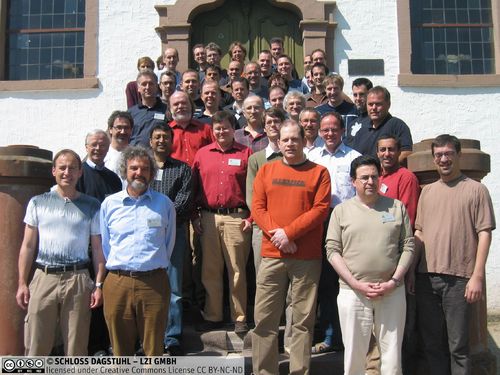Dagstuhl-Seminar 07171
Visual Computing – Convergence of Computer Graphics and Computer Vision
( 22. Apr – 27. Apr, 2007 )
Permalink
Organisatoren
- Markus Gross (ETH Zürich, CH)
- Heinrich Müller (TU Dortmund, DE)
- Hans-Peter Seidel (MPI für Informatik - Saarbrücken, DE)
- Harry Shum (Microsoft Research Asia - Beijing, CN)
Kontakt
Presse/News
Press Release
"Naturgetreue Bilder und Simulationen verdrängen Textverarbeitung am Computer" 02.04.07(German only)
Due to the importance of visual information for humans, visual computing is at the very core of the technologies enabling the modern information society. New and emerging technologies such as multimedia, digital television, telecommunication and telepresence, virtual reality, or 3D-internet further indicate the tremendous potential of visual in the years to come. Typical for the field is the coincidence of very large data sets with the demand for fast, if possible interactive, user-adapted high quality visual display of the results. Furthermore, the user should be able to interact with the environment in a natural and intuitive way.
In order to address the challenges mentioned above, a new and more integrated scientific view of Visual Computing is required that unifies the previously separate ”visual” disciplines of computer graphics and computer vision. Computer graphics is traditionally concerned with generating visual interfaces of computers and applications to the user. Computer vision focuses on enabling computers to understand and interpret visual information from static images and video sequences.
The seminar considered the whole pipeline from data acquisition over processing to rendering, including perceptional issues. This approach made it possible to uncover synergies between computer graphics and computer vision research.
The seminar had three types of sessions: research talks, keynotes, and break-out sessions. Apart from concrete research problems, several fundamental questions were addressed in particular in the latter two formats:
- Generation of visual content
- Analysis by synthesis
- Level of resolution
- Engineering versus science
- Modeling of human characters
It became clear during the seminar that the fields of computer vision and computer graphics are not only closely related, but are mutually dependent. As techniques are exchanged between the fields, computer graphics and computer vision are converging into a discipline of visual computing. Using the knowledge about generative and analytic techniques that is available at both ends of the spectrum leads to the development of more robust and efficient tools able to handle the huge amounts of data that are typically dealt with. The understanding of both aspects of visual data, how to analyze it as well as how to generate it, helps in identifying fundamental principles that govern the processing of visual data in a computer. This knowledge leads to the development of better representations and primitive operations on a well-founded theoretical base, allowing use to replace heuristic and fragile approaches by robust and reliable methods in visual computing.
- Marc Alexa (TU Berlin, DE) [dblp]
- Volker Blanz (Universität Siegen, DE) [dblp]
- Mario Botsch (ETH Zürich, CH) [dblp]
- Joachim M. Buhmann (ETH Zürich, CH) [dblp]
- Hans Burkhardt (Universität Freiburg, DE)
- Nikolaos Canterakis (Universität Freiburg, DE)
- Daniel Cohen-Or (Tel Aviv University, IL) [dblp]
- Oliver Deussen (Universität Konstanz, DE) [dblp]
- George Drettakis (INRIA Sophia Antipolis - Méditerranée, FR)
- Frédo Durand (MIT - Cambridge, US)
- Philip Dutré (KU Leuven, BE)
- Thomas Ertl (Universität Stuttgart, DE) [dblp]
- Dieter W. Fellner (TU Darmstadt, DE) [dblp]
- Eugene Fiume (University of Toronto, CA)
- Jürgen Gall (MPI für Informatik - Saarbrücken, DE) [dblp]
- Michael Goesele (TU Darmstadt, DE) [dblp]
- Günther Greiner (Universität Erlangen-Nürnberg, DE)
- Markus Gross (ETH Zürich, CH) [dblp]
- Stefan Gumhold (TU Dresden, DE)
- Marc Hanheide (Universität Bielefeld, DE) [dblp]
- Sven Havemann (TU Graz, AT)
- Wolfgang Heidrich (University of British Columbia - Vancouver, CA) [dblp]
- Aaron Hertzmann (University of Toronto, CA) [dblp]
- Ivo Ihrke (Universität des Saarlandes, DE) [dblp]
- Jan Kautz (University College London, GB) [dblp]
- Leif Kobbelt (RWTH Aachen, DE) [dblp]
- Reinhard Koch (Universität Kiel, DE) [dblp]
- Hendrik P. A. Lensch (Universität Ulm, DE) [dblp]
- Dani Lischinski (The Hebrew University of Jerusalem, IL)
- Marcus A. Magnor (TU Braunschweig, DE) [dblp]
- Heinrich Müller (TU Dortmund, DE)
- Karol Myszkowski (MPI für Informatik - Saarbrücken, DE)
- Carol O'Sullivan (Trinity College Dublin, IE) [dblp]
- Dinesh Pai (University of British Columbia - Vancouver, CA) [dblp]
- Mark Pauly (EPFL - Lausanne, CH) [dblp]
- Marc Pollefeys (ETH Zürich, CH) [dblp]
- Werner Purgathofer (TU Wien, AT)
- Bodo Rosenhahn (Leibniz Universität Hannover, DE) [dblp]
- Stefan Roth (TU Darmstadt, DE) [dblp]
- Dietmar Saupe (Universität Konstanz, DE) [dblp]
- Andreas Schilling (Universität Tübingen, DE)
- Philipp Slusallek (Universität des Saarlandes, DE) [dblp]
- Oliver Staadt (Universität Rostock, DE) [dblp]
- Eckehard Steinbach (TU München, DE)
- Luc Van Gool (KU Leuven, BE) [dblp]
- Michael Waschbüsch (ETH Zürich, CH)
- Joachim Weickert (Universität des Saarlandes, DE) [dblp]
- Rüdiger Westermann (TU München, DE) [dblp]
- Tim Weyrich (Princeton University, US) [dblp]
- Martin Wicke (ETH Zürich, CH)
Klassifikation
- computer graphics / computer vision
Schlagworte
- Image- and video-based modeling and rendering
- perception-guided modeling and rendering
- texture synthesis
- scattering and reflectance measurement and rendering
- capturing reality (appearance
- motion) from images
- 3D acquisition and display
- 3D reconstruction
- image and model compression
- computational photography
- high dynamic range imaging


